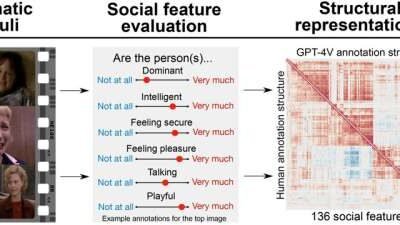AI Research
First global medical AI foundation model drives 100-country research collaboration
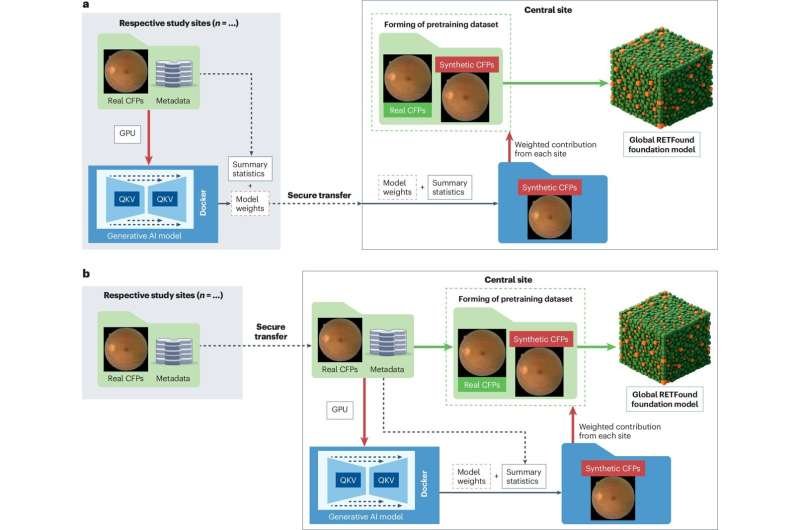
A global research consortium of over 100 study groups in more than 65 countries has launched the Global RETFound initiative, a collaborative effort to develop the first globally representative Artificial Intelligence (AI) foundation model in medicine, using 100 million eye images.
As described in Nature Medicine, the initiative is one of the largest medical AI collaborations ever undertaken, producing one of the most geographically and ethnically diverse medical datasets assembled for AI training purposes. The data will span Africa, the Middle East, South America, Southeast Asia, the Western Pacific, and the Caucasus region.
Led by researchers from the National University of Singapore Yong Loo Lin School of Medicine (NUS Medicine), Moorfields NHS Foundation Trust, University College London (UCL), and the Chinese University of Hong Kong (CUHK), the consortium will develop its model using an unprecedented dataset of over 100 million color fundus photographs (photos of the back of the eye), sourced from more than 65 countries.
The global initiative builds on the success of RETFound, the first foundation model for retinal and systemic disease detection. Published in Nature in 2023, RETFound was originally developed by researchers at Moorfields Eye Hospital and UCL Institute of Ophthalmology in London. The proof-of-concept study involved a smaller scale of 1.6 million fundus photographs curated by the INSIGHT Health Data Research Hub at Moorfields.
While RETFound demonstrated potential for medical AI applications, the next global model will expand the training data to encompass every continent except Antarctica.
“Current foundational models are trained on data that is geographically and demographically ‘narrow’, which limits their effectiveness and can perpetuate existing health inequalities,” explained Dr. Yih Chung Tham, Assistant Professor at NUS Medicine, and a NUS Presidential Young Professor, one of the key project leads. “The Global RETFound Consortium addresses this challenge through innovative approaches that enable broad international participation at unprecedented scale, while maintaining data privacy protections.”
A key innovation of the project is its flexible, two-pronged data sharing framework, designed to accommodate varying technical capacities and regulatory requirements across participating institutions. The first approach involves local fine-tuning of generative AI models at individual institutions, with only model weights shared centrally, ensuring no patient data leaves the originating site. The second pathway enables direct sharing of de-identified data through secure infrastructure for institutions that do not have local GPU resources or technical expertise.
“This dual approach allows participation from research groups regardless of their resource levels,” noted Pearse Keane, Professor of Artificial Medical Intelligence at UCL. “By combining real and synthetic data generation techniques, we can build a diverse, globally representative dataset without compromising security.”
Prof. Carol Cheung from The Chinese University of Hong Kong emphasized the broader implications: “This initiative has the potential to establish new international benchmarks for generalizability and fairness in medical AI. By providing researchers worldwide with access to a ‘globally-trained’ foundation model, we can accelerate development of AI tools tailored to local clinical needs with substantially reduced data and computational requirements.”
Dr. Tham added, “The Global RETFound model will undergo comprehensive evaluation across multiple ophthalmic and systemic diseases, including diabetic retinopathy, glaucoma, age-related macular degeneration and cardiovascular diseases. The model will be released under a Creative Commons license, making it freely and publicly available for non-commercial research use worldwide.”
While ophthalmology serves as the initial blueprint for such a collaborative framework, the researchers aim to share their methodologies widely, laying the groundwork for similar global initiatives across other medical specialties.
The project addresses growing concerns about AI bias in health care while demonstrating how international collaboration can advance medical AI development in an equitable way. The consortium welcomes additional researchers and institutions to join their collaborative effort towards more inclusive medical AI development.
More information:
Yih Chung Tham et al, Building the world’s first truly global medical foundation model, Nature Medicine (2025). DOI: 10.1038/s41591-025-03859-5
Citation:
First global medical AI foundation model drives 100-country research collaboration (2025, September 9)
retrieved 9 September 2025
from https://medicalxpress.com/news/2025-09-global-medical-ai-foundation-country.html
This document is subject to copyright. Apart from any fair dealing for the purpose of private study or research, no
part may be reproduced without the written permission. The content is provided for information purposes only.
AI Research
2 Artificial Intelligence (AI) Leaders
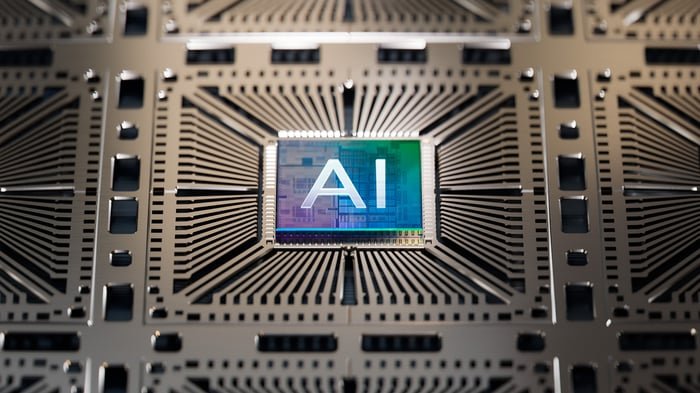
Key Points
-
Companies can’t get enough AI chips, and that spells more growth for Taiwan Semiconductor Manufacturing.
-
Apple has competitive advantages that could make it a sleeper AI stock to buy right now.
-
10 stocks we like better than Taiwan Semiconductor Manufacturing ›
The artificial intelligence (AI) market is expected to add trillions to the global economy, and investors looking for rewarding buy-and-hold investments in the field don’t need to take high risks. Investing in companies that are supplying the computing hardware to power AI technology, as well as those that could benefit from growing adoption of AI-powered consumer products, could earn satisfactory returns. Here are two stocks to consider buying for the long term.
Image source: Getty Images.
Where to invest $1,000 right now? Our analyst team just revealed what they believe are the 10 best stocks to buy right now. Continue »
1. Taiwan Semiconductor Manufacturing
AI doesn’t work without the right chips to train computers to think for themselves. While Nvidia and Broadcom report strong growth, Taiwan Semiconductor Manufacturing (NYSE: TSM) is the one making the chips for these semiconductor companies. TSMC controls over 65% of the chip foundry market, according to Counterpoint, making it the default chip factory for smartphones, computers, and AI.
TSMC manufactures chips that are used in several other markets, including automotive and smart devices. This means that when one market is weak, such as automotive, strength from another (high-performance computing and AI, for example) can pick up the slack.
TSMC’s manufacturing capacity is immense. It can make 17 million 12-inch equivalent silicon wafers every year.
Its massive scale and expertise at making the most advanced chips in the world put it in a lucrative position. Over the last year, it earned $45 billion in net income on $106 billion of revenue. It has delivered double-digit annualized revenue growth over the last few decades, and management expects this growth to continue.
In the second quarter, revenue grew 44% year over year. This growth has pushed the stock up 51% over the past year. Management expects AI chip revenue to grow at an annualized rate in the mid-40s range over the next five years, which is a catalyst for long-term investors.
With Wall Street analysts expecting the company’s earnings per share to grow at an annualized rate of 21% in the coming years, the stock should continue to hit new highs, as it still trades at a reasonable forward price-to-earnings ratio (P/E) of 24.
2. Apple
Apple (NASDAQ: AAPL) hasn’t made a huge splash in AI yet. Apple Intelligence brought some useful features to its devices, such as AI summaries and image creation, but it’s not as robust as customers were expecting. However, investors shouldn’t count the most valuable consumer brand out just yet. Apple has a large installed base of active devices, and millions of customers trust Apple with their personal data, which could put it in a strong position to benefit from AI over the long term.
Apple previously partnered with OpenAI for ChatGPT integration across its products, but with OpenAI now positioning itself as a competitor after bringing in Apple’s former product designer Jony Ive, Apple is rumored to be exploring a partnership with Alphabet‘s Google’s Gemini to power its Siri voice assistant.
Apple appears to be a sleeping giant in AI. Millions of people are walking around with a device that Apple can turn into a super-intelligent assistant with a single software update. Its large installed base of over 2.35 billion active devices is a major advantage that shouldn’t be underestimated.
But Apple has another important advantage that other tech companies can’t match: consumer trust. Apple has built its brand around protecting user privacy, whereas Alphabet’s Google and Meta Platforms have profited off their users’ data to grow their advertising revenue. A partnership with Google for AI would not comprise Apple’s position on user privacy, since Google would need to provide a custom model that runs on Apple’s private cloud.
For these reasons, Apple is well-positioned to be a leader in AI, making its stock a solid buy-and-hold investment. It says a lot about its growth potential that analysts still expect earnings to grow 10% per year despite the fact that the company is lagging behind in AI. The stock’s forward P/E of 32 is on the high side, but that also reflects investor optimism about its long-term prospects.
Should you invest $1,000 in Taiwan Semiconductor Manufacturing right now?
Before you buy stock in Taiwan Semiconductor Manufacturing, consider this:
The Motley Fool Stock Advisor analyst team just identified what they believe are the 10 best stocks for investors to buy now… and Taiwan Semiconductor Manufacturing wasn’t one of them. The 10 stocks that made the cut could produce monster returns in the coming years.
Consider when Netflix made this list on December 17, 2004… if you invested $1,000 at the time of our recommendation, you’d have $671,288!* Or when Nvidia made this list on April 15, 2005… if you invested $1,000 at the time of our recommendation, you’d have $1,031,659!*
Now, it’s worth noting Stock Advisor’s total average return is 1,056% — a market-crushing outperformance compared to 185% for the S&P 500. Don’t miss out on the latest top 10 list, available when you join Stock Advisor.
See the 10 stocks »
*Stock Advisor returns as of September 8, 2025
John Ballard has positions in Nvidia. The Motley Fool has positions in and recommends Alphabet, Apple, Meta Platforms, Nvidia, and Taiwan Semiconductor Manufacturing. The Motley Fool recommends Broadcom. The Motley Fool has a disclosure policy.
Disclaimer: For information purposes only. Past performance is not indicative of future results.
AI Research
Agentic AI Market Size, Share & Growth Report by 2033
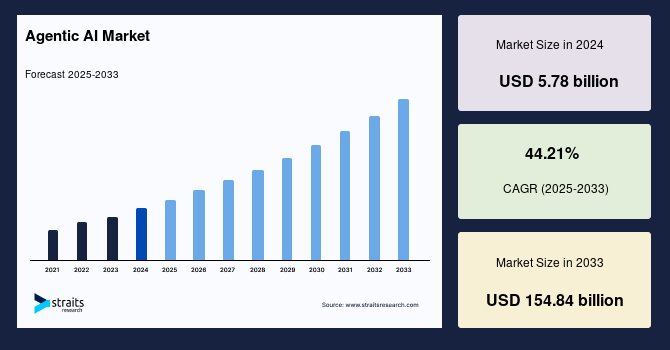
Agentic AI Market Overview
The global agentic AI market size was valued at USD 5.78 billion in 2024 and is estimated to grow from USD 8.31 billion in 2025 to reach USD 154.84 billion by 2033, growing at a CAGR of 44.21% during the forecast period (2025–2033). Rising demand for intelligent automation, enhanced decision-making, and efficiency across enterprises is driving the agentic AI market. Advanced ML, multi-agent systems, and ready-to-deploy solutions enable scalable operations, improved customer experiences, and reduced operational costs worldwide.
Key Market Trends & Insights
- North America held the largest market share, over 40% of the global market.
- By technology, the machine learning segment held the highest market share of over 30.5%.
- By agent system, the single agent systems segmentis expected to witness the fastest CAGR of 47.14%.
- By type, the ready-to-deploy agents segment is expected to witness the fastest CAGR of 42.44%.
- By application, the customer service and virtual assistants segment held the highest market share of over 30%
- By end-user, the enterprise segment held the highest market share of over 35%.
Market Size & Forecast
- 2024 Market Size: USD 78 billion
- 2033 Projected Market Size: USD 84 billion
- CAGR (2025-2033): 21%
- North America: Largest market in 2024
Agentic AI refers to artificial intelligence systems capable of acting independently to achieve goals, rather than only responding to human instructions. These AI agents can plan, make decisions, and execute tasks autonomously, often using reinforcement learning, natural language processing, and advanced algorithms. By continuously observing environments, predicting outcomes, and adapting strategies, agentic AI can solve complex problems, manage workflows, or optimize operations with minimal human intervention, effectively functioning as self-directed digital agents.
The growth of agentic AI is fueled by advancements in computational power, cloud infrastructure, and real-time data analytics, enabling faster and more efficient autonomous operations. Industries such as healthcare, logistics, and finance can leverage agentic AI to enhance precision, reduce operational costs, and improve service delivery. Moreover, integration with IoT and robotics presents opportunities for innovative applications, from smart manufacturing to personalized services, allowing organizations to automate complex tasks while gaining insights for strategic decision-making.
Latest Market Trend
Shift toward autonomous decision-making
The global agentic AI market is witnessing a clear shift toward autonomous decision-making, where AI agents are moving beyond simple task execution to making context-aware, strategic choices with minimal human intervention. This trend is fueled by advances in generative AI, reinforcement learning, and multi-agent collaboration systems.
Businesses are increasingly adopting these autonomous agents to handle dynamic operations such as supply chain optimization, financial trading, and customer engagement. The ability of agentic AI to adapt, self-learn, and respond in real time enhances efficiency and scalability. As trust and explainability improve, autonomous decision-making is becoming a defining feature of next-gen AI adoption.
Market Driver
Rising investments in AI research
Rising investments in AI research are a key driver of the global agentic AI market, enabling rapid advancements in autonomy, reasoning, and multi-agent collaboration. Major technology companies, governments, and venture capital firms are increasingly funding projects that push the boundaries of intelligent decision-making systems.
- For instance, in July 2025, Thinking Machines Lab, founded by former OpenAI CTO Mira Murati, secured a record-breaking $2 billion Series A funding round at a $10 billion valuation, underscoring investor confidence in agentic AI.
Such significant capital inflows accelerate innovation, attract top talent, and drive the commercialization of next-generation AI solutions across industries worldwide.
Market Restraint
High computational and infrastructure costs
High computational and infrastructure costs remain a major restraint in the global agentic AI market. Deploying advanced agentic AI systems requires powerful GPUs, high-performance cloud platforms, and extensive storage to process vast datasets. This leads to significant capital expenditure, making adoption difficult for small and mid-sized enterprises.
Moreover, ongoing expenses for system maintenance, energy consumption, and software updates further strain budgets. These high costs limit large-scale deployment and create disparities between tech giants and smaller players, slowing down overall market penetration.
Market Opportunity
Emerging applications in defense & space
Emerging applications in defense and space present significant opportunities for the agentic AI market, as militaries and space agencies increasingly seek autonomous solutions for complex and high-risk operations. Agentic AI enables real-time decision-making, mission planning, and multi-agent coordination in environments where human intervention is limited or unsafe.
- For instance, in May 2025, Applied Intuition introduced two defense-focused product lines—Axion and Acuity—designed to accelerate deployment of autonomous systems across air, land, sea, and space. Notably, the company also converted a GM Infantry Squad Vehicle to full autonomous operation within just 10 days, showcasing rapid adaptability.
Such advancements highlight how agentic AI is becoming central to next-generation defense strategies and space exploration initiatives.

- 📊 Preview Report Scope and Structure – Gain immediate visibility into key topics, market segments, and data frameworks covered.
- 📥 Evaluate Strategic Insights – Access selected charts, statistics, and analyst-driven commentary derived from the final report deliverables.
Regional Analysis
North America: Dominant Region
North America remains the dominant region in the agentic AI market, supported by advanced technological infrastructure, strong R&D capabilities, and robust investment in AI-driven innovation. The region leads in enterprise adoption across sectors such as finance, healthcare, and retail, where AI agents streamline operations and customer engagement. For example, major automotive firms in North America are integrating multi-agent systems for autonomous vehicle testing and deployment. With a mature digital ecosystem and significant venture funding, the region continues to set benchmarks for global agentic AI adoption.
- The United States agentic AI market is witnessing strong adoption across enterprises, driven by demand for automation, customer service enhancement, and intelligent decision-making tools. Companies are deploying ready-to-deploy agents to streamline workflows, improve productivity, and personalize customer experiences. With extensive use cases in sectors such as financial services, healthcare, and defense, the U.S. is rapidly scaling AI-driven innovations.
- Canada’s agentic AI market is expanding steadily, with enterprises embracing AI to optimize processes, improve service delivery, and enhance decision-making. Industries such as healthcare, logistics, and retail are integrating intelligent agents to manage complex operations more efficiently. Ready-to-deploy solutions are particularly popular, helping businesses achieve faster digital transformation without heavy technical resources.
Asia-Pacific: Significantly Growing Region
The Asia-Pacific region is experiencing significant growth in the agentic AI market, fueled by rapid digitalization, strong government support, and expanding enterprise adoption. Countries across the region are deploying agentic AI in applications like e-commerce, financial services, and manufacturing, driving both efficiency and innovation.
For example, leading telecom operators in Asia-Pacific have integrated virtual assistants to handle large-scale customer service demands, reducing costs while enhancing user satisfaction. With increasing investments in AI infrastructure and rising demand for intelligent automation, the region is emerging as a global growth hotspot.
- China’s agentic AI market is accelerating, supported by large-scale investments, strong government backing, and an ecosystem of leading tech companies. Enterprises are leveraging multi-agent systems and machine learning-based agents for applications in manufacturing, smart cities, and retail. The rise of AI-powered virtual assistants and robotics in consumer and enterprise sectors highlights China’s leadership in applied innovation.
- India’s agentic AI market is growing rapidly, driven by digital transformation initiatives across industries such as banking, healthcare, and e-commerce. Enterprises are adopting ready-to-deploy agents for customer service, process automation, and data-driven decision-making. The increasing demand for multilingual virtual assistants is also boosting adoption, catering to the country’s diverse user base. With strong government-led AI initiatives and expanding startup ecosystems, India is positioning itself as a key growth hub.
Market Segmentation
The global agentic AI market is bifurcated by technology, agent system, type, application, and end-user.
Technology Insights
The Machine Learning segment dominates the global agentic AI market, driving advanced predictive capabilities, decision-making, and automation across industries. Its ability to learn from data, adapt to patterns, and optimize outcomes makes it the backbone of intelligent agents. From fraud detection and recommendation engines to autonomous navigation, machine learning algorithms are powering scalable and reliable agentic solutions. With rising adoption in finance, healthcare, and enterprise automation, machine learning remains the key technology propelling innovation and shaping the competitive edge in agentic AI.
Agent System Insights
The multi-agent systems segment dominates the agentic AI landscape, offering collaborative intelligence where multiple agents interact to achieve complex objectives. This approach enables scalability, resilience, and real-time adaptability in dynamic environments. Widely applied in logistics, defense, and smart city infrastructure, these systems enhance decision-making by distributing tasks across interconnected agents. Their ability to manage interdependencies and deliver coordinated outcomes makes them essential for industries demanding efficiency and autonomy.
Type Insights
The Ready-to-Deploy Agents segment dominates the market, offering organizations pre-built, easily integrable solutions that reduce development costs and deployment time. Businesses increasingly favor these agents for applications like customer service, IT helpdesks, and process automation, where quick implementation is crucial. Their plug-and-play nature allows enterprises to scale AI adoption without heavy technical expertise, making them ideal for improving productivity and user experience. As demand for faster time-to-value rises, ready-to-deploy agents continue to capture the largest market share.
Application Insights
The Customer Service and Virtual Assistants segment represents the largest application segment, dominating due to the growing enterprise focus on enhancing customer experience. These AI-driven agents handle inquiries, resolve issues, and provide 24/7 support, reducing operational costs while improving satisfaction. From retail and banking to telecom, virtual assistants streamline interactions and personalize services, making them indispensable for businesses. With advancements in natural language processing and conversational AI, this segment is expanding rapidly in the global market.
End-User Insights
The Enterprise segment dominates the agentic AI market, as organizations adopt intelligent agents to optimize operations, decision-making, and customer engagement. Enterprises leverage these systems for automating workflows, managing resources, and enhancing productivity across multiple departments. From HR and finance to supply chain and marketing, agentic AI enables cost savings, efficiency, and data-driven insights. With the growing demand for scalability, security, and personalization, enterprises are leading adoption, positioning themselves at the forefront of leveraging agentic AI.
Company Market Share
The agentic AI market is characterized by strong competition, with leading companies focusing on diverse strategies to expand their presence. Many are investing heavily in research and development to advance machine learning, natural language processing, and multi-agent system capabilities. Others are concentrating on building ready-to-deploy agents to meet growing enterprise demand for rapid integration and scalability.
OpenAI
OpenAI, started in 2015 as an AI research organization, has evolved from open collaboration to building advanced large language models. With milestones like GPT series, it now pioneers agentic AI, focusing on autonomous systems, reasoning, and safer, scalable intelligence to transform industries while ensuring responsible innovation.
- In August 2025, OpenAI officially released GPT-5, introducing it as its most advanced and intelligent model to date. Featuring a unified system that swiftly balances quick responses with deeper reasoning, GPT-5 demonstrates expert-level performance across coding, health, writing, and multimodal tasks, significantly reducing hallucinations and boosting usability.
List of key players in Agentic AI Market
- Alibaba Group Holding Limited
- Amazon Web Services, Inc.
- Apple Inc.
- Baidu
- IBM Corporation
- Meta
- Microsoft
- NVIDIA Corporation
- Salesforce, Inc.
- Anthropic
- C3.ai
- CrewAI
- LivePerson
- Moveworks
- NICE Ltd.
- OpenAI
- Oracle
- ServiceNow

Recent Development
- February 2025 – GitHub launched Agent Mode for GitHub Copilot, significantly improving its AI-powered coding capabilities. The update enables Copilot to autonomously process high-level instructions, generate code spanning multiple files, detect errors, and apply fixes with minimal human guidance.
Agentic AI Market Segmentations
By Technology (2021-2033)
- Machine Learning
- Natural Language Processing (NLP)
- Deep Learning
- Computer Vision
- Others
By Agent System (2021-2033)
- Single Agent Systems
- Multi-Agent Systems
By Type (2021-2033)
- Ready-to-Deploy Agents
- Build-Your-Own Agents
By Application (2021-2033)
- Customer Service and Virtual Assistants
- Robotics and Automation
- Healthcare
- Financial Services
- Security and Surveillance
- Gaming and Entertainment
- Marketing and Sales
- Human Resources
- Legal and Compliance
- Others
By End-User (2021-2033)
- Consumer
- Enterprise
- Industrial
By Region (2021-2033)
-
North America
- U.S.
- Canada
-
Europe
- U.K.
- Germany
- France
- Spain
- Italy
- Russia
- Nordic
- Benelux
- Rest of Europe
-
APAC
- China
- Korea
- Japan
- India
- Australia
- Taiwan
- South East Asia
- Rest of Asia-Pacific
-
Middle East and Africa
- UAE
- Turkey
- Saudi Arabia
- South Africa
- Egypt
- Nigeria
- Rest of MEA
-
LATAM
- Brazil
- Mexico
- Argentina
- Chile
- Colombia
- Rest of LATAM
Frequently Asked Questions (FAQs)
The global agentic AI market size was valued at USD 5.78 billion in 2024 and is estimated to grow from USD 8.31 billion in 2025 to reach USD 154.84 billion by 2033, growing at a CAGR of 44.21% during the forecast period (2025–2033).
Rising investments in AI research are a key driver of the global agentic AI market, enabling rapid advancements in autonomy, reasoning, and multi-agent collaboration.
The Ready-to-Deploy Agents segment dominates the market, offering organizations pre-built, easily integrable solutions that reduce development costs and deployment time.
AI Research
Optibus announces expansion of generative AI capabilities for transit schedulin and operations
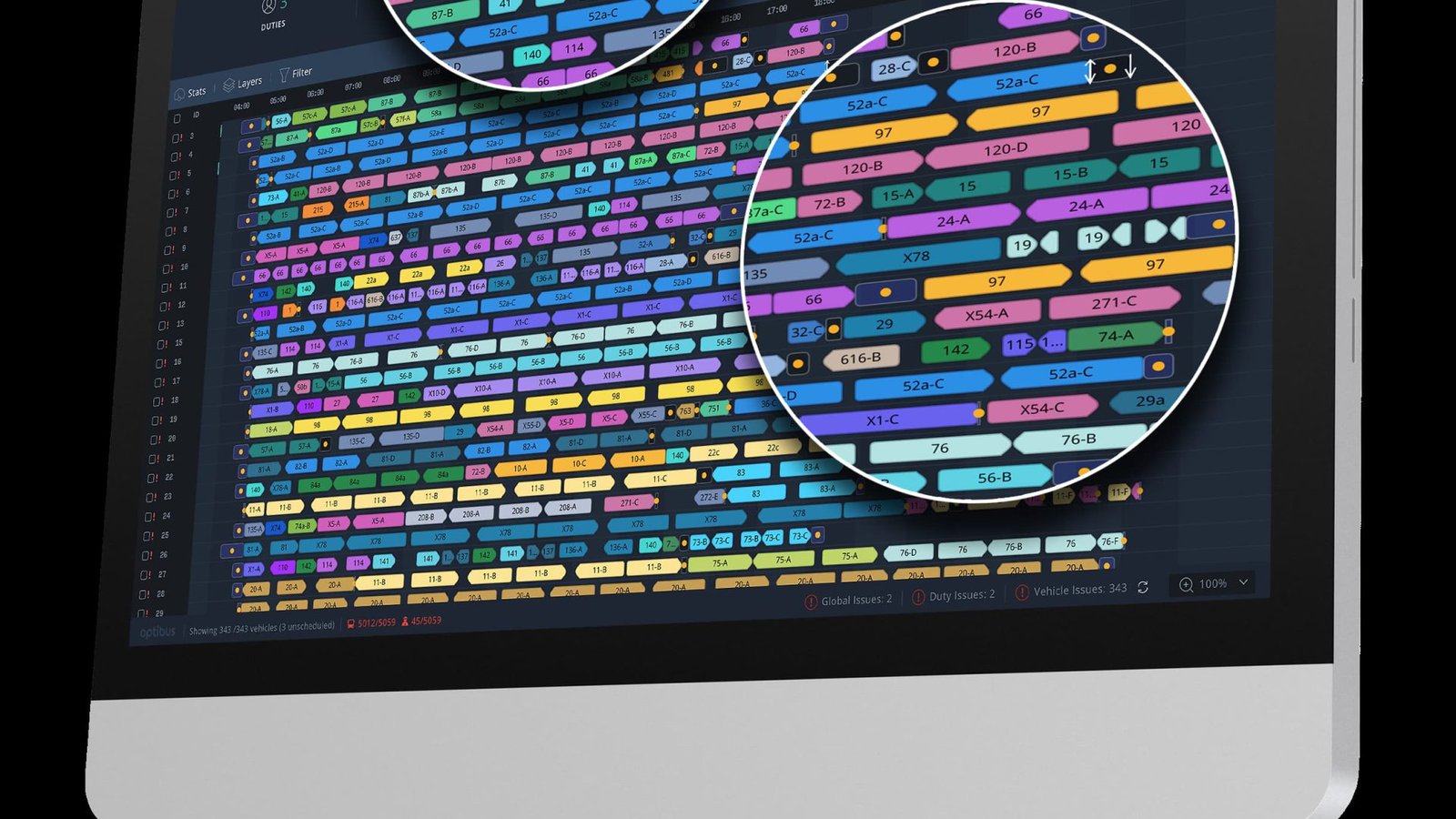
Optibus announces it has introduced new capabilities to Optibus AI, that the company claims being the “first Generative Artificial Intelligence (GenAI) suite purpose-built for public and private operators and agencies”.
Optibus AI features a growing number of industry-specific AI agents fully integrated across the platform. “Tools are embedded where and when transportation professionals need them most. With intelligence layers for every stage of work, agencies and operators can redefine planning, scheduling, and beyond with intuitive, platform-native capabilities”, the Israeli tech company states.
Optibus expands Artificial Intelligence skills
Optibus suite suite includes a Generative AI agent that uses natural language to create complex scheduling rules: “Schedulers type preferences in plain language, such as “No more than ten duties over nine hours,” and Optibus instantly generates accurate, ready-to-use logic. No more specialized coding, configuration, or steep learning curves. Just fast, intuitive scheduling powered by AI”, reads Optibus announcement.
Preference Designer is said as reducing errors and rule configuration time by up to 70%.
Additional AI agents are on the way, including Schedule Analysis, allowing to compare optimized scenarios and charting the best path forward, and persuade stakeholders with presentation-ready analysis and actionable insights. Optibus is also set to introduce Multi-Step Automation.
According to Optibus’ industry survey, 95% of public transportation enterprises have explored artificial intelligence, but only 8% noted measurable impact. Across industries, insufficient integration into existing workflows is a key cause of unsuccessful AI trials.
Amos Haggiag, CEO and co-founder of Optibus, said: “Generative AI is kicking-off a new chapter in how public transportation is planned and operated. Optibus AI turns decades of complex processes into simple, intuitive tools that empower teams at every level.”
-

 Business2 weeks ago
Business2 weeks agoThe Guardian view on Trump and the Fed: independence is no substitute for accountability | Editorial
-
Tools & Platforms4 weeks ago
Building Trust in Military AI Starts with Opening the Black Box – War on the Rocks
-

 Ethics & Policy1 month ago
Ethics & Policy1 month agoSDAIA Supports Saudi Arabia’s Leadership in Shaping Global AI Ethics, Policy, and Research – وكالة الأنباء السعودية
-

 Events & Conferences4 months ago
Events & Conferences4 months agoJourney to 1000 models: Scaling Instagram’s recommendation system
-

 Jobs & Careers2 months ago
Jobs & Careers2 months agoMumbai-based Perplexity Alternative Has 60k+ Users Without Funding
-

 Podcasts & Talks2 months ago
Podcasts & Talks2 months agoHappy 4th of July! 🎆 Made with Veo 3 in Gemini
-

 Education2 months ago
Education2 months agoMacron says UK and France have duty to tackle illegal migration ‘with humanity, solidarity and firmness’ – UK politics live | Politics
-

 Education2 months ago
Education2 months agoVEX Robotics launches AI-powered classroom robotics system
-

 Funding & Business2 months ago
Funding & Business2 months agoKayak and Expedia race to build AI travel agents that turn social posts into itineraries
-

 Podcasts & Talks2 months ago
Podcasts & Talks2 months agoOpenAI 🤝 @teamganassi


